DigitalPro Shooter Volume 4, Issue 2, January 9, 2006 If you're one of those who only uses Photoshop for its core photo editing capabilities, and doesn't need the dozens of other graphic arts features or the complex user interface, then Lightroom or one of the new breed of photographer specific editors is just the ticket for you. In this issue of DigitalPro Shooter we'll look at the newly announced Adobe Lightroom and also talk a little about how it compares with Apple's Aperture and LightZone from LightCrafts. The first big change in Photoshop's editing paradigm since Layers came with the introduction of Camera Raw. Camera Raw allows non-destructive application of some fairly sophisticated image processing directly on the camera's raw data. The obvious question photographers began to ask is why they couldn't have those same powerful functions for use with their JPEGs (like Bibble offers) and in Photoshop itself. Changing Photoshop entirely to address the needs of photographers is impractical, so Adobe has built Lightroom "from the ground up" (their words, not mine) to meet the needs of the serious photographer. LightRoom: Something Old, Something NewMuch of Lightroom will be familiar to photographers. Basic image adjustment commands combine elements from Camera Raw and Photoshop to provide a photo-centric editor that applies editing commands without modifying the underlying image. This notion of non-destructive editing was revived by various Raw processors after several years of neglect and then taken to a new level by LightZone and Aperture--which combine image editing capability with raw processing in a non-destructive editing environment. The appeal is considerable, since you can reverse your edits, apply them to batches of images, and all without consuming disk space. However, since there is no universal way for those edits to be applied, to use an image outside of Lightroom you need to save it out as some industry standard format, typically TIFF or JPEG, or maybe PSD if you want to transfer it to Photoshop.
Lightroom: The part of Photoshop you need?
Adobe obviously has all the Photoshop technology at its disposal, so we'll see more processing capabilities added to Lightroom during the beta. Final judgement on the product will lhave to wait until user feedback helps shape the combination of features & interface that Adobe ships late this year when Lightroom becomes a product. Lightroom: Maximal Slideshows & Flexible PrintingGoodbye Photoshop?In 2002 the image editing landscape in photography land had settled down fairly well. Practically everyone used Photoshop for image editing. The only real debate was over what plug-ins might be worth acquiring alongside. Then, along with the popularity of Raw files, raw image processors such as Bibble and Nikon Capture were added to photographers' workflow. Now there is a new class of editor that combine turbo-charged Raw processors with a subset of Photoshop's editing capability. The first of these was Lightzone from Lightcraft, introduced at DEMO last fall. Quickly on its heels Apple introduced Aperture, and only a month later Adobe is out touting Lightroom. Since Lightroom won't ship until late 2006 and Adobe has virtually never done a public beta of a major product before now it's easy to guess that they are reacting to market pressure from the competition--especially Aperture--trying to make sure that if photographers are going to defect from Photoshop they do it to another Adobe product. Interestingly, none of these new products claim to replace Photoshop. Nor do they want to be viewed as just raw processors. But frankly, there is a limit to how many image editing applications a photographer is going to use on a regular basis. So the winner is likely to be whichever application best meets the bulk of photographers' needs at a reasonable price and with good performance. Currently all of these products are in beta or have just shipped their 1.0 versions so it is really too early to predict a winner or even an early leader as they all have a lot of growing to do, but the good news is that all three are available for evaluation downloads so you can try them out as they evolve and see which ones fulfill your needs. Even better news is that all three companies are open about their desire for photographer feedback--which is one reason they've opened up their beta programs. The Products: A Quick SummaryHere are the top items that strike me from looking at each of these products in their current state: Adobe Lightroom
Apple Aperture
LightCrafts LightZone
The Products: Where to get them
The future of Photo Editing?It is clear that photographer-specific editing tools are finally here. As they improve there is little doubt most of us will be using them for our photo processing needs. They will also take advantage of increased computer horsepower to do non-destructive editing, allowing us to save multiple renderings of an image without creating multiple copies. The only potential downside is that non-destructive editing software requires lists of editing commands (called "edit lists") to be applied to the original image to get the desired final output. And right now every product uses its own unique format for those lists. So the evolution of standards for edit lists, their contents and how they are stored, will be critical for photographers who want access to their images without being locked in to a particular vendor. --David Cardinal, Editor, DigitalPro Shooter Other New ProductsMicrosoft Raw Viewer & Thumbnailer updated: Microsoft has updated their Raw image viewer & thumbnailer to add support for new cameras and fix some issues the original version had with locking files. It also features improved performance and memory utilization. You can download it here. Nikon 18-200 AF-S/VR lens shipping: This is a very sweet little lens. I really haven't had a chance to benchmark mine to see how it performs technically thorughout its range, but was easily able to use it to take some great "family photos" over the holidays. It's large range and small size aren't unique, as third party lens makers have had 18-200 lenses for awhile. But none of the third party lenses have ever taken images this good or auto-focused as fast. This lens also has VR, which is a nice addition to any lens that you're likely to want to use from a boat or truck or when a tripod is impractical. I was happy to purchase mine. The zoom ring can seem a little stiff, although supposedly it will loosen up over time (I hope not too much:-). The lens does have a fair amount of pincushion and barrel distortion as would be expected in a zoom with that wide a range. B&H has it for $749 and lists it as in stock, while Roberts has it for $670, but only shows a waiting list. Magix has introduced PhotoStory on CD & DVD 4. For users looking for a more powerful but inexpensive alternative to Microsoft's free PhotoStory for Windows, Magix has a very competent product offering. I've been experimenting with it and like the fairly simple user interface which is still powerful enough to allow you to create flexible timelines and audio tracks. Magix PhotoStory can produce movies or CD or DVD slideshows. I'll be doing a more complete review of it and ProShow Producer (a much more expensive product) in a future DPS. Magix PhotoStory retails for $39.99. DigitalPro Tip
Did you know that you can add a new disk drive to your Windows XP system
without adding a drive letter? If you format the new drive as NTFS you can
access it as a folder under an existing drive instead of with a new drive
letter. Just use the Disk Management function in Computer Management. If you
need to store your images under multiple drive letters, the Favorites mode
of DigitalPro's File Cabinet lets
you see just the drives and folders you want to for filing your images.
--David Cardinal, Editor, DigitalPro Shooter |
Search our Sites:
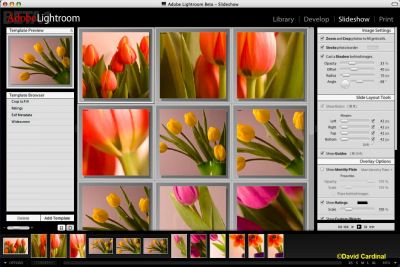
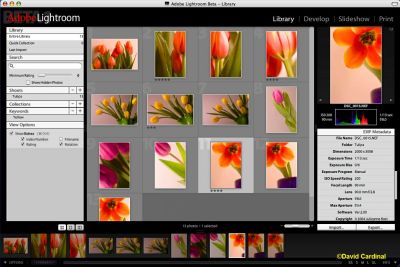
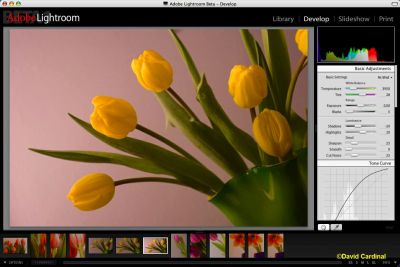
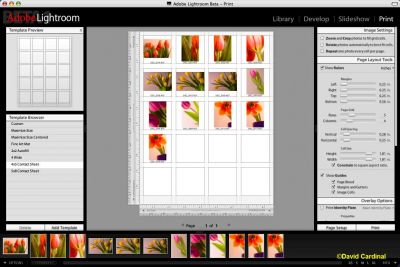
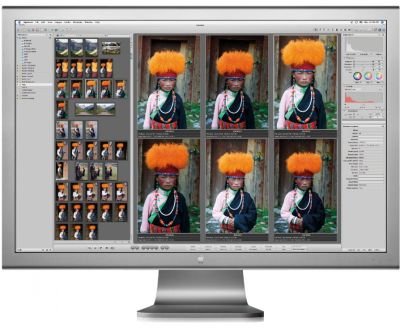 Aperture offers a slick interface
if your Mac has the horsepower
Aperture offers a slick interface
if your Mac has the horsepower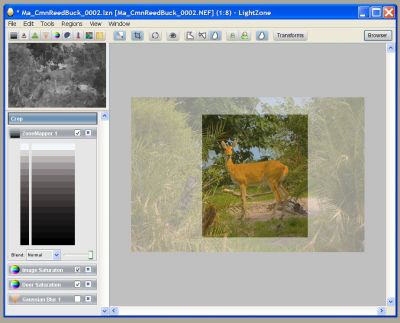 LightZone provides non-destructive cropping.
Allows multiple renderings for a single image
LightZone provides non-destructive cropping.
Allows multiple renderings for a single image


